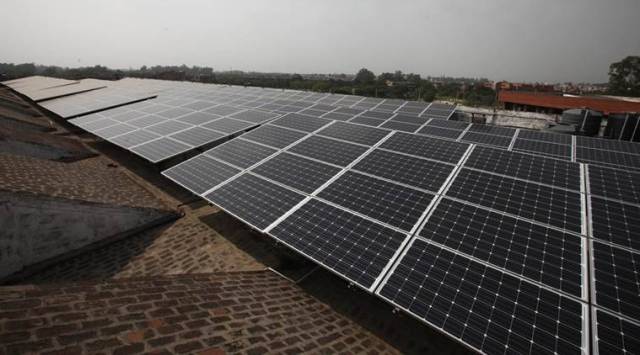Green growth one of 7 saptarishis, Nirmala keeps climate central to budget again
The Centre is to facilitate one crore farmers to adopt natural farming over the next three years, for which 10,000 bio-input resource centres will be set-up.
 Sitharaman today announced a slew of measures for climate action in the budget including a green credit programme to be notified under the Environment (Protection) Act to incentivise and "mobilise additional resources for environmentally sustainable and responsive actions’’. (File)
Sitharaman today announced a slew of measures for climate action in the budget including a green credit programme to be notified under the Environment (Protection) Act to incentivise and "mobilise additional resources for environmentally sustainable and responsive actions’’. (File) Union Finance Minister Nirmala Sitharaman made a green push for the Centre’s budget 2023-24, calling ‘green growth’ one of the seven goals, or “saptrishis’’ in this “first budget of the Amrit Kal’’. The finance minister carried forward last year’s focus on energy transition and climate action, keeping it front and centre of this year’s budget as well, particularly significant with India’s G20 presidency and keeping in line with India’s positioning as a global leader in climate action, and its leadership position representing the developing world at various international negotiations including the Conference of Parties.
Sitharaman today announced a slew of measures for climate action in the budget including a green credit programme to be notified under the Environment (Protection) Act to incentivise and “mobilise additional resources for environmentally sustainable and responsive actions’’.
The finance minister further announced 500 new ‘waste to wealth’ plants under GOBARdhan (Galvanizing Organic Bio Agro Resources Dhan) scheme to be established for promoting circular economy at a total investment of Rs 10,000 crore, 5 per cent compressed biogas mandate to be introduced for all organisations marketing natural and bio gas and annual production of 5 MMT under the Green Hydrogen Mission by 2030 to reduce dependence on fossil fuel imports.
The Centre is to facilitate one crore farmers to adopt natural farming over the next three years, for which 10,000 bio-input resource centres will be set-up.
The finance minister further announced Rs 35,000 crore outlay for energy security, energy transition and net zero objectives. Rs 20,700 crore outlay has been provided for renewable energy grid integration and evacuation from Ladakh.
The finance minister has further announced the “PM Programme for Restoration, Awareness, Nourishment and Amelioration of Mother Earth” (PM-PRANAM) to incentivise States and UTs to promote alternative fertilisers and balanced use of chemical fertilisers. The Amrit
Dharohar scheme is to be implemented over the next three years to encourage optimal use of wetlands, enhance biodiversity, carbon stock, eco-tourism opportunities and income generation for local communities.
Sitharaman has also announced ‘Mangrove Initiative for Shoreline Habitats and Tangible Incomes’ (MISHTI) for mangrove plantation along the coastline and on salt pan lands.
“This is a ‘stay-the-course’ budget on green growth, with the possible exception of support for hydrogen, but not, as yet, a green transformation inducing budget. In several areas it seeks to stimulate green production but focuses less on green development – using renewable energy for an inclusive transition and promoting rural productivity,” said IPCC author and CPR’s Professor Navroz K Dubash.
“This is definitely an ambitious green growth budget. What is disappointing is that there is no institutional structure in place to ensure implementation of climate action. Measures to reduce carbon intensity have been announced across sectors and ministries but there is no nodal agency in place to monitor the spending and climate action,’’ said IPCC author Dr Anjal Prakash.
Several other announcements which found space in Sitharaman’s budget speech, were simply a reiteration of announcements that had been made by her last year – increasing the scope of PARIVESH, the environment ministry’s single window system to facilitate environment clearances, impetus to public transport in urban areas and EVs and the issue of Green Bonds, among others.
In keeping with the Centre’s attention to improving air quality, allocation for the National Clean Air Programme has been increased to Rs 756 crore, from Rs 600 crore. But experts say the messaging on air pollution is mixed, with progress in clean technology and transportation, but a phasing out of subsidies for LPG which helped in abating household pollution.
“The increased funding for NCAP is welcome, but the lack of attention to crop residue management or crop diversification means there is unlikely to be any substantial improvement in crop residue burning this winter,’’ said Dr Bhargav Krishna, Fellow at CPR.
Union Budget 2023: All you need to know
- ↗️ Finance Minister Nirmala Sitharaman’s Union Budget 2023 has some big takeaways
- ↗️ First, what everyone has been looking forward to: changes in the new income tax regime. She has made the new tax regime more attractive. There are changes in the rebate limit and in tax slabs. What does this mean for the taxpayer?
- ↗️ FM Sitharaman proposed a 33% increase in capital investment outlay, raising it to Rs 10 lakh crore. This is the biggest in the past decade. What does it mean?
- ↗️ Some articles get cheaper and others get costlier due to changes in customs duty. Here is a list
- ↗️ The capital outlay for the railways has been increased to the highest ever – Rs 2.40 lakh crore. The government is trying to create more jobs
- ↗️ FM Sitharaman said the fiscal deficit will fall to 5.9% of the GDP. What does it mean for the stakeholders?
- ↗️ The FM called it the ‘first Budget of Amrit Kaal’. PM Narendra Modi said it will build a strong foundation for a developed India. What did opposition leaders say?







- 01
- 02
- 03
- 04
- 05
























